2020年仁爱版九年级上册英语教学案UniTopic2Topic3SectionC
- 格式:doc
- 大小:93.50 KB
- 文档页数:13
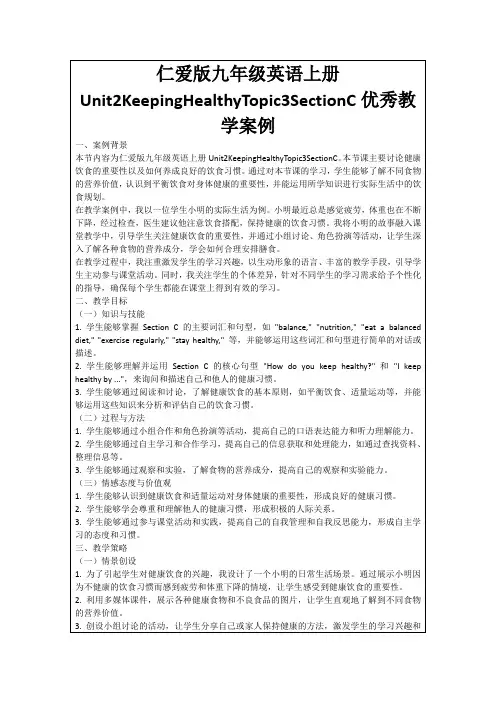
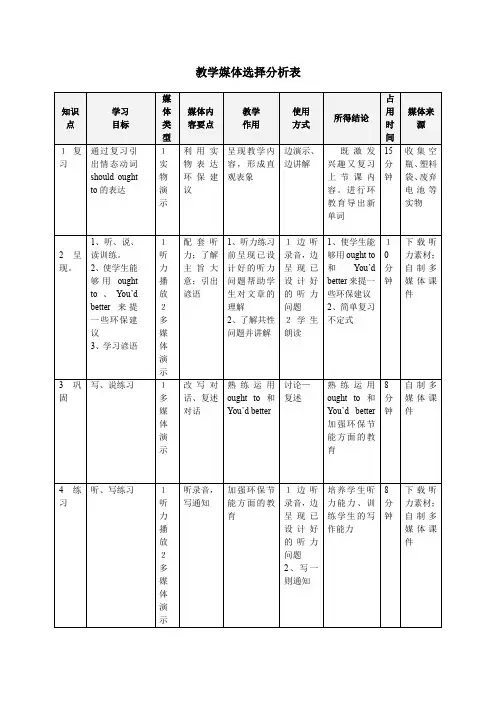
教学媒体选择分析表教学设计方案赠送以下资料《背影》教学设计【教学目标】知识与能力:学习本文选取动人情景,生动描写人物,以情感人的方法。
过程与方法:感受作者朴实的语言风格。
情感态度与价值观:通过体味文章所表现的父子之间的深情,培养学生懂得感受爱,也懂得回报爱的优良品德。
【教学重点、难点】1、作者对“父亲买橘子”的背影方法。
2、儿子对父亲的关心的不解、顿悟、感念的过程。
【预习设计】1、学生需认真朗读全文,弄懂重点词语的音、形、义;2、整体感知文章主要内容,注意事件发生的背景;3、你是如何看待文中的父亲和儿子的?【教学过程】一、导入新课运用多媒体播放歌曲《父亲》,并欣赏一首小诗。
“父爱是拐杖,让我们在人生中少摔跟头。
父爱是良言,让我们作出正确的判断。
父爱是阳光,让我们健康的成长。
父爱是音乐,让我们快快乐乐的生活。
父爱是蜡烛,默默的为我们奉献着自己。
”今天,就让我们一起来学习《背影》,看看这篇文章感人至深的地方究竟在哪里?二、检查预习(小组之内检查)1、正音练习:给加粗的词注音。
变卖典质(diǎn zhì) 颓唐(tuí) 狼藉(jí)交卸(xiè) 奔丧(bèn sāng) 簌簌(sù)晶莹(yíng) 迂腐(yū) 琐屑(suǒxiè)栅栏(zhà) 差使(chāi) 照看行李(kān)妥帖(tuǒ) 蹒跚(pán shān) 踌躇(chóu chú)2、根据解释填词语。
乱七八糟的样子。
狼藉失业在家。
赋闲凄惨暗淡,不景气。
惨淡因为腿脚不灵便,走路缓慢摇摆的样子。
蹒跚言行守旧,不合时宜。
迂腐细小而繁多的事。
琐屑不幸的事接二连三的发生。
祸不单行把自己的财产、衣服出卖和典当出去。
变卖典质精神不振作。
颓唐三、朗读课文,交流探讨1、刚才我已经说过,《背影》是一篇脍炙人口的名篇,几十年来为人们所传诵,这说明大家在读这篇文章的时候肯定给大家留下极其深刻的印象,或者产生了某方面的疑惑,那么同学们在读这篇文章的时候,有没有特别深刻的印象或疑惑。
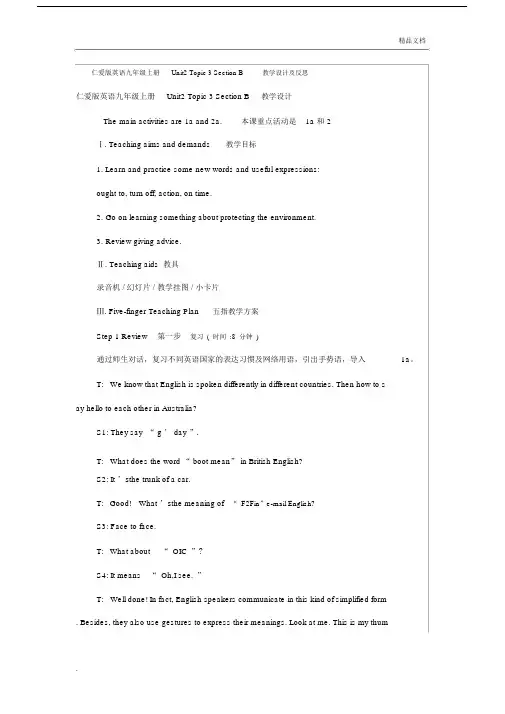
精品文档仁爱版英语九年级上册Unit2 Topic 3 Section B教学设计及反思仁爱版英语九年级上册Unit2 Topic 3 Section B教学设计The main activities are 1a and 2a.本课重点活动是1a 和 2Ⅰ. Teaching aims and demands教学目标1.Learn and practice some new words and useful expressions:ought to, turn off, action, on time.2.Go on learning something about protecting the environment.3.Review giving advice.Ⅱ. Teaching aids 教具录音机 / 幻灯片 / 教学挂图 / 小卡片Ⅲ. Five-finger Teaching Plan五指教学方案Step 1 Review第一步复习(时间:8分钟)通过师生对话,复习不同英语国家的表达习惯及网络用语,引出手势语,导入1a。
T:We know that English is spoken differently in different countries. Then how to say hello to each other in Australia?S1: They say “ g ’ day ”.T:What does the word “ boot mean” in British English?S2: It ’s the trunk of a car.T: Good! What ’s the meaning of“ F2Fin”e-mail English?S3: Face to face.T: What about“ OIC”?S4: It means“ Oh,I see.”T:Well done! In fact, English speakers communicate in this kind of simplified form. Besides, they also use gestures to express their meanings. Look at me. This is my thumb. I put out my hand with my thumb raised. (做拇指朝上伸出手的动作。
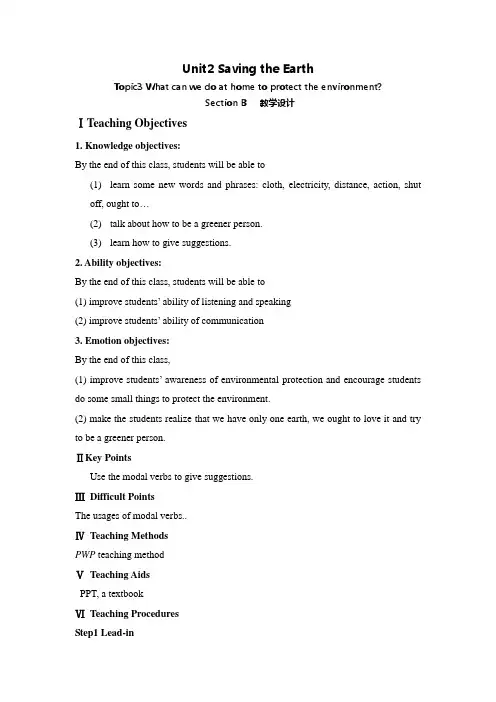
Unit2 Saving the EarthTopic3 What can we do at home to protect the environment?Section B 教学设计ⅠTeaching Objectives1. Knowledge objectives:By the end of this class, students will be able to(1)learn some new words and phrases: cloth, electricity, distance, action, shutoff, ought to…(2)talk about how to be a greener person.(3)learn how to give suggestions.2. Ability objectives:By the end of this class, students will be able to(1) improve students’ ability of listening and speaking(2) improve students’ ability of communication3. Emotion objectives:By the end of this class,(1) improve students’ awareness of environmental protection and encourage students do some small things to protect the environment.(2) make the students realize that we have only one earth, we ought to love it and try to be a greener person.ⅡKey PointsUse the modal verbs to give suggestions.ⅢDifficult PointsThe usages of modal verbs..ⅣTeaching MethodsPWP teaching methodⅤTeaching AidsPPT, a textbookⅥTeaching ProceduresStep1 Lead-inWatch a short videoThe purpose is to lead to the topic. According to the video, students will be able to get some information about the environmental pollution in our life.Step2 Pre-listening1. Discuss some pictures about how to protect the environment… (The purpose is to make the students know some background information about the listening material.)2. New words learning.(cloth, electricity, shut off, ought to…)The teacher presents the new words by using the pictures and creating relative satiations. (The new vocabulary input will make it easier for student when they listen to the conversation.)Step3 While-listening1. Listen to the conversation and try to answer one question. (What are they talking about?) The purpose is to grasp the main idea of the conversation.2. Listen to the conversation and complete the table. (This step aims at making the students know some details about the conversation.)3. Watch a video, try to imitate the pronunciation and intonation.Step4 Post-listening1. Practice the conversation in pairs and then act it out. The purpose is to consolidate the conversation.2. Discuss the idioms in the conversation and show more idioms to students to encourage them to use the idioms often.3. Retell the conversation according to the mind map. By changing the conversation into a short passage, the purpose is to improve students’ writing ability.4. Talk about how to protect the environment in our school. The group which gives the most and best suggestions will be the winner and they will be honored as “The Best Greener Person”Step6 SummaryNew words and phrases:cloth, electricity, distance, action, shut off, ought to…Useful expressions:1. Easier said than done.2.Actions speak louder than words.Step7 Blackboard designUnit2 Saving the EarthTopic3 What can we do at home to protect the environment?Section BNew words and phrases:cloth, electricity, distance, action, shut off,ought to Useful expressions:1. Easier said than done.2.Actions speak louder than words.。
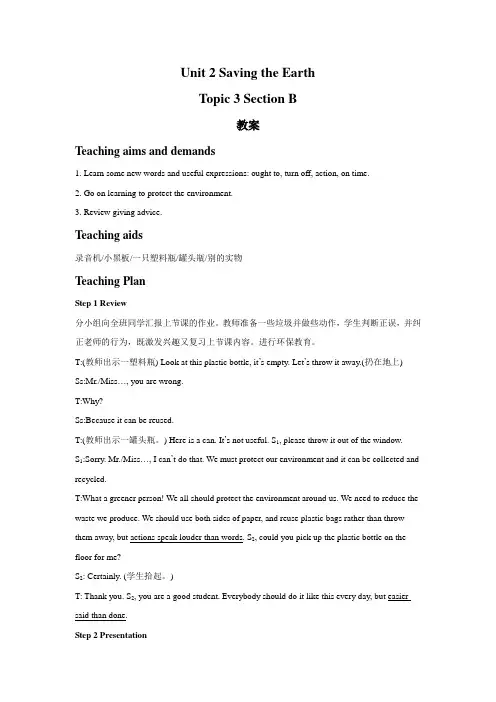
Unit 2 Saving the EarthTopic 3 Section B教案Teaching aims and demands1. Learn some new words and useful expressions: ought to, turn off, action, on time.2. Go on learning to protect the environment.3. Review giving advice.Teaching aids录音机/小黑板/一只塑料瓶/罐头瓶/别的实物Teaching PlanStep 1 Review分小组向全班同学汇报上节课的作业。
教师准备一些垃圾并做些动作,学生判断正误,并纠正老师的行为,既激发兴趣又复习上节课内容。
进行环保教育。
T:(教师出示一塑料瓶) Look at this plastic bottle, it’s empty. Let’s throw it away.(扔在地上) Ss:Mr./Miss…, you are wrong.T:Why?Ss:Because it can be reused.T:(教师出示一罐头瓶。
) Here is a can. It’s not useful. S1, please throw it out of the window.S1:Sorry. Mr./Miss…, I can’t do that. We must protect our environment and it can be collected and recycled.T:What a greener person! We all should protect the environment around us. We need to reduce the waste we produce. We should use both sides of paper, and reuse plastic bags rather than throw them away, but actions speak louder than words. S2, could you pick up the plastic bottle on the floor for me?S2: Certainly. (学生拾起。
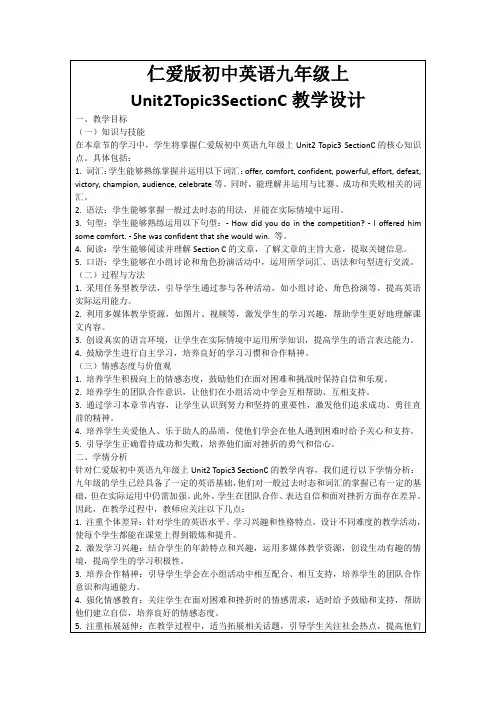
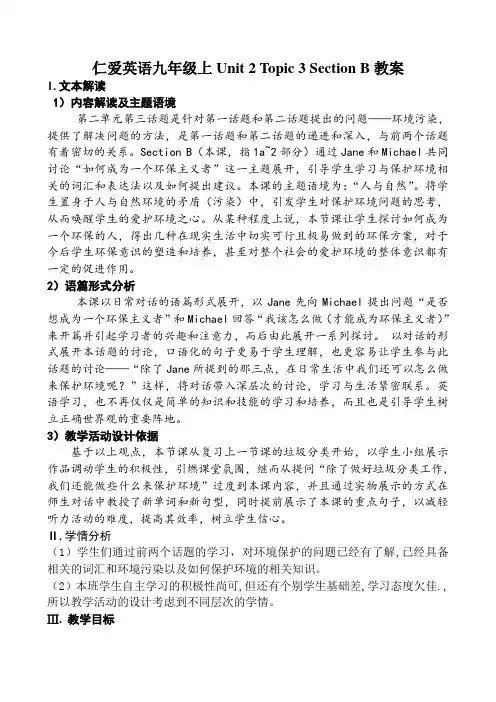
仁爱英语九年级上Unit 2 Topic 3 Section B教案I.文本解读1)内容解读及主题语境第二单元第三话题是针对第一话题和第二话题提出的问题——环境污染,提供了解决问题的方法,是第一话题和第二话题的递进和深入,与前两个话题有着密切的关系。
Section B(本课,指1a~2部分)通过Jane和Michael共同讨论“如何成为一个环保主义者”这一主题展开,引导学生学习与保护环境相关的词汇和表达法以及如何提出建议。
本课的主题语境为:“人与自然”。
将学生置身于人与自然环境的矛盾(污染)中,引发学生对保护环境问题的思考,从而唤醒学生的爱护环境之心。
从某种程度上说,本节课让学生探讨如何成为一个环保的人,得出几种在现实生活中切实可行且极易做到的环保方案,对于今后学生环保意识的塑造和培养,甚至对整个社会的爱护环境的整体意识都有一定的促进作用。
2)语篇形式分析本课以日常对话的语篇形式展开,以Jane先向Michael提出问题“是否想成为一个环保主义者”和Michael回答“我该怎么做(才能成为环保主义者)”来开篇并引起学习者的兴趣和注意力,而后由此展开一系列探讨。
以对话的形式展开本话题的讨论,口语化的句子更易于学生理解,也更容易让学生参与此话题的讨论——“除了Jane所提到的那三点,在日常生活中我们还可以怎么做来保护环境呢?”这样,将对话带入深层次的讨论,学习与生活紧密联系。
英语学习,也不再仅仅是简单的知识和技能的学习和培养,而且也是引导学生树立正确世界观的重要阵地。
3)教学活动设计依据基于以上观点,本节课从复习上一节课的垃圾分类开始,以学生小组展示作品调动学生的积极性,引燃课堂氛围,继而从提问“除了做好垃圾分类工作,我们还能做些什么来保护环境”过度到本课内容,并且通过实物展示的方式在师生对话中教授了新单词和新句型,同时提前展示了本课的重点句子,以减轻听力活动的难度,提高其效率,树立学生信心。
Ⅱ.学情分析(1)学生们通过前两个话题的学习,对环境保护的问题已经有了解,已经具备相关的词汇和环境污染以及如何保护环境的相关知识。
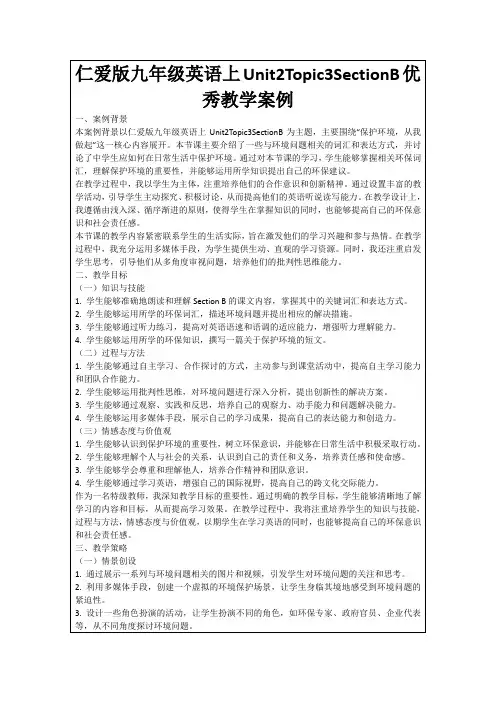
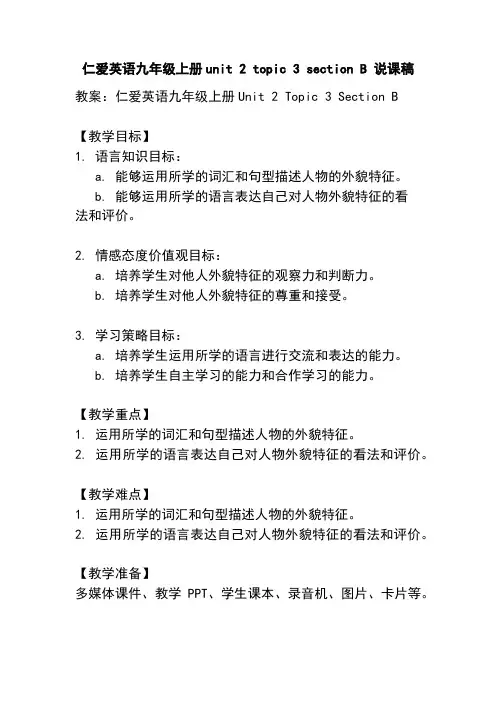
仁爱英语九年级上册unit 2 topic 3 section B 说课稿教案:仁爱英语九年级上册Unit 2 Topic 3 Section B【教学目标】1. 语言知识目标:a. 能够运用所学的词汇和句型描述人物的外貌特征。
b. 能够运用所学的语言表达自己对人物外貌特征的看法和评价。
2. 情感态度价值观目标:a. 培养学生对他人外貌特征的观察力和判断力。
b. 培养学生对他人外貌特征的尊重和接受。
3. 学习策略目标:a. 培养学生运用所学的语言进行交流和表达的能力。
b. 培养学生自主学习的能力和合作学习的能力。
【教学重点】1. 运用所学的词汇和句型描述人物的外貌特征。
2. 运用所学的语言表达自己对人物外貌特征的看法和评价。
【教学难点】1. 运用所学的词汇和句型描述人物的外貌特征。
2. 运用所学的语言表达自己对人物外貌特征的看法和评价。
【教学准备】多媒体课件、教学PPT、学生课本、录音机、图片、卡片等。
【教学过程】Step 1:导入新课(5分钟)1. 向学生展示一张图片,让学生观察图片中的人物外貌特征。
2. 引导学生用英语描述图片中的人物外貌特征。
Step 2:新课讲解(15分钟)1. 向学生展示并讲解新词汇,如hair, eyes, nose,mouth等。
2. 向学生展示并讲解新句型,如What does he/she look like? He/She has...等。
3. 向学生展示并讲解相关的语法知识,如形容词的用法和位置等。
Step 3:练习与巩固(15分钟)1. 让学生听录音,跟读并模仿录音中的对话。
2. 分组让学生进行对话练习,描述自己或他人的外貌特征。
3. 让学生用所学的语言描述一位名人的外貌特征,并向同伴介绍。
Step 4:拓展与运用(10分钟)1. 让学生观察教师给出的一些图片,并用所学的语言描述图片中的人物外貌特征。
2. 让学生自由发挥,用所学的语言描述自己或他人的外貌特征,并向同伴介绍。
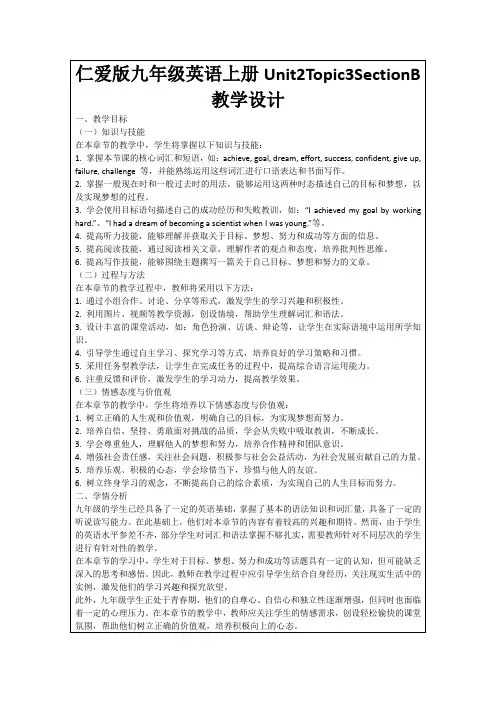
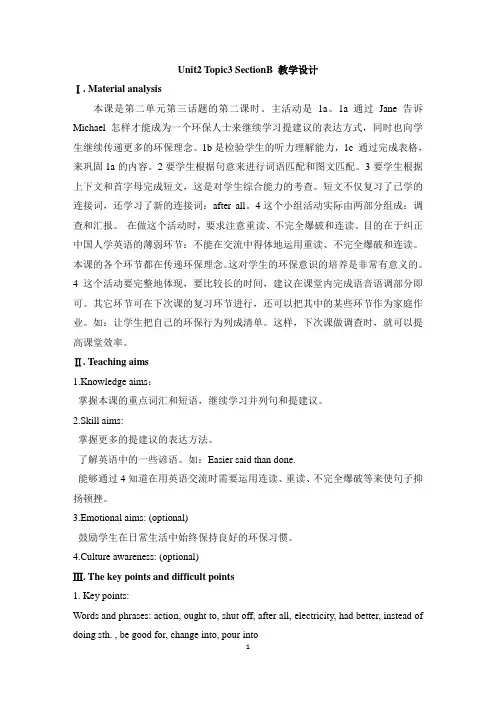
Unit2 Topic3 SectionB 教学设计Ⅰ. Material analysis本课是第二单元第三话题的第二课时。
主活动是1a。
1a 通过Jane 告诉Michael怎样才能成为一个环保人士来继续学习提建议的表达方式,同时也向学生继续传递更多的环保理念。
1b是检验学生的听力理解能力,1c 通过完成表格,来巩固1a的内容。
2要学生根据句意来进行词语匹配和图文匹配。
3要学生根据上下文和首字母完成短文,这是对学生综合能力的考查。
短文不仅复习了已学的连接词,还学习了新的连接词:after all。
4这个小组活动实际由两部分组成:调查和汇报。
在做这个活动时,要求注意重读、不完全爆破和连读。
目的在于纠正中国人学英语的薄弱环节:不能在交流中得体地运用重读、不完全爆破和连读。
本课的各个环节都在传递环保理念。
这对学生的环保意识的培养是非常有意义的。
4这个活动要完整地体现,要比较长的时间,建议在课堂内完成语音语调部分即可。
其它环节可在下次课的复习环节进行,还可以把其中的某些环节作为家庭作业。
如:让学生把自己的环保行为列成清单。
这样,下次课做调查时,就可以提高课堂效率。
Ⅱ. Teaching aims1.Knowledge aims:掌握本课的重点词汇和短语,继续学习并列句和提建议。
2.Skill aims:掌握更多的提建议的表达方法。
了解英语中的一些谚语。
如:Easier said than done.能够通过4知道在用英语交流时需要运用连读、重读、不完全爆破等来使句子抑扬顿挫。
3.Emotional aims: (optional)鼓励学生在日常生活中始终保持良好的环保习惯。
4.Culture awareness: (optional)Ⅲ. The key points and difficult points1. Key points:Words and phrases: action, ought to, shut off, after all, electricity, had better, instead of doing sth. , be good for, change into, pour into1Sentences: First, you ought to shut off the electricity when you leave a room.Second, you’d better walk or ride a bike instead of taking a bus or a taxi if you travel a short distance.Don’t use plastic bags.Easier said than done.Actions speak louder than words.After all, we have only one earth.We should do everything to protect it, or we’ll be punished and lose our home.Grammar: compound sentence2.Difficult points:掌握重读、连读和不完全爆破的技巧。
:Unit2 Topic 3 Would you like to be a greener personSection B教学设计福安四中黄妍摘要:随着工业化的高速发展,人民生活水平的日益提高的同时也带来了气候变化,全球变暖,森林面积减少,淡水资源遭受污染。
引领社会绿色理念,倡导绿色生活、生产方式和社会可持续发展成为全国乃至全球人民守卫我们共同家园的努力方向。
作为中学生要树立起保护环境节能减排从我做起的责任感。
本节课的英语教学利用信息技术从学生们身边的实例出发,简单直观,让学生人人参与,激发学生的是非观,荣辱观,让学生在课堂教学中人人有话可说,有话想说,有话要说。
实现把英语做为语言工具灵活运用的目的。
关键词:绿色生活;英语教学;信息技术;语言工具一.教材分析:本课是仁爱版初中英语九年级上Unit2Topic3 SectionB.此部分利用Michael 和Jane 两人的对话及海滩清洁日活动教育学生成为环保小卫士。
以观看视频,讨论,思考,制作环保标语等形式进行教和学。
从学生身边的事渗透环保,从小事做起从身边做起,加深学生对环境保护的理解,增强学生热爱环境保护环境的意识。
[二.学情分析:按照让学生能积极参与,探究,体验,创新,合作,自主学习的要求,在教学中以学生为中心,设计丰富的活动和任务,创设情景,鼓励学生积极参与,增强趣味性本课根据初中生的特点,设计了一系列的活动,让其积极参与,成为课堂学习的主人,提高学生的学习能力,提高英语的学习效率。
三.教学内容:教材p43中1a,1b和p44 中2a,2b ,2c.四.教学课型:新授课(听说课,读写课,综合任务活动课)五.教学目标:1.知识与技能:;⑴词汇:ought to, distance, cloth, action, battery⑵语法:ought to +动词原形,ought not to +动词原形⑶话题:To be a greener personer.2.过程与方法:运用教材内容进行“听,读”练习,结合生活事例“说”环保,再进行写的练习——制作环保标语。
Unit 2 Saving the EarthTopic 3 Would you like to be a greener person?SectionCThe main activities are 1a and 2. 本课重点活动是1a和2。
Ⅰ. Teaching aims and demands 教学目标1. Learn a new word:technology, electric, wheel, steel2. Go on learning some compound sentences:(1) In many countries, people produce power from coal, but it is very dirty and causes acid rain.(2) Although electric vehicles produce no pollution, there will be an increase in electricity needs if they are widely used.3. Learn the advantages and disadvantages of some kinds of energy.Ⅱ. Teaching aids 教具挂图/图片/小黑板或幻灯片/录音机Ⅲ. Five-finger Teaching Plan 五指教学方案Step 1 Review 第一步复习(时间:10分钟)通过对节能环保知识的复习讨论,导入新课,教学部分生词。
1. (通过对上一课1a的复习,强调怎样做才能成为绿色使者, 进一步增强学生的环保意识,同时也营造一种英语氛围,激发学生的学习兴趣。
)T: Can you remember what we have learned in Section B?Ss: Yes.(教师可以出示上一课1a的图片。
)T: What are Jane and Michael doing?Ss: They are talking about how to be a greener person.T: Can you tell me how to be a greener person?Ss: First, turn off the lights when we leave a room.T: What about the next?Ss: Walk or ride a bike instead of taking a bus or a taxi …T: Very good. Please go on.Ss: Take a cloth bag when we go shopping.T: Great. It’s easier said than done. So we have to keep on doing that every day.2. (让学生分组讨论节约能源的各种方法,以旧带新,导入新课主题。
Topic 3 What can we do at home to protect the environment?Section AⅠ. Material analysis本课是第二单元第三话题的第一课时。
主活动是1a和2。
1a 通过记者采访Jane,询问有关Jane 在环保组织的活动,引出话题内容:如何做一个环保人士。
通过介绍在生活中如何践行环保行为,自然地用到本话题的功能意念:提出建议。
在提出建议的同时,又引出本话题的语法:并列句。
1b是个难度比较高的听力任务。
它不是单纯地考查听写,而是要求学生在听懂内容的基础上,对材料进行归纳之后再填空。
1c是用第一人称来转述1a的内容,旨在向学生传播环保理念。
2是针对并列句而设计的专项语法训练。
3a和3b 是在考查学生的垃圾分类意识之后,再通过听对话来进行验证。
4再次让学生对垃圾进行分类,以此来培养学生对垃圾再利用的环保理念。
通过学习本课,可以增强学生的环保意识。
培养学生在写作时运用连接词写出比较连贯的句子的能力。
Ⅱ. Teaching aims1.Knowledge aims:掌握本课的重点词汇和短语,初步学习并列句和提建议。
2.Skill aims:能够给别人提出合理的建议。
能够正确地运用连接词写出并列句。
能够把所听到的听力材料先归纳再填空。
3.Emotional aims: (optional)鼓励学生在日常生活中自觉践行环保行为。
4.Culture awareness: (optional)Ⅲ. The key points and difficult points1. Key points:Words and phrases: nod, agreement, disagreement, protection, organization, recycle, can, give up, so that, encourage sb to do sth.be harmful to sb./sth.Sentences: We should reduce the waste we produce.We should use both sides of paper and reuse plastic bags.It’s a pleasure.Recycling can protect the environment, and it can save money, too.So we encourage students to collect waste paper and soft drink cans.Grammar: compound sentence2.Difficult points:根据句子需要,正确地选用连接词。
Topic 3Unit 2 Saving the EarthTopic 3 Section C教案Teaching aims and demands1. Learn a new word: electric2. Learn some compound sentences: They work well, but they are slow and can’t run for long.3. Learn some Finds of energy and their advantages and disadvantages.Teaching aids录音机/挂图/图片/幻灯片/小黑板Teaching PlanStep 1 Review1.通过对上一课1a的复习,强调怎样做才能成为绿色使者, 进一步增加学生的环保意识,同时也创造一种英语氛围。
T: Can you remember what we have learned in Section B?Ss: Yes.T: Can you remember Jane and Michael?Ss: Yes.(教师可以出示上一课1a图片。
)T: What are Jane and Michael doing?Ss: They are talking about how to be a greener person.T: What should they do?Ss: First, turn off the lights when leaving a room.T: What about the next?Ss: Walk or ride a bike instead of taking a bus or a taxi …T: Very good, please go on.Ss: Take a cloth bag when we go shopping.T: Great. It’s easier said than done. So take action from now on.(通过整体复习为学生复述课文打下基础。
2020年精编仁爱版英语资料
Section C
Ⅰ. Material analysis
本课是第二单元第三话题的第三课时。
主活动是1a。
1a 介绍了世界各地的人们如何开发和利用环境友好型和资源节约型的新能源,同时也指出了这些新能源的利用方式所存在的不足之处。
在介绍的过程中,让学生学到更多并列句的连接词。
如:however, not only…but also…等。
1b通过图片匹配可以帮助学生形象地理解比较陌生的事物。
1c培养学生归纳处理信息的能力。
2a和2b 是两个关联性很强的任务。
2a指出人们可以利用可再生能源来发电,并让学生讨论怎样利用这些可再生能源,然后在2b环节形成书面报告。
这两个环节,其实是培养学生学会作记录,并根据记录整理成短文的能力。
2b是个书面活动,可以留作家庭作业。
Ⅱ.Teaching aims
1.Knowledge aims:
掌握本课的重点词汇和短语,继续学习并列句。
2.Skill aims:
学会更多连接并列句的方法。
学会在讨论中作记录,并整理记录使之成文。
能够对信息进行分类处理。
3.Emotional aims: (optional)
激发学生探索利用新能源的热情。
4.Culture awareness: (optional)
了解世界各国在开发和利用新能源方面的现状和成就。
Ⅲ. The key points and difficult points
1. Key points:
Words and phrases: technology, renewable, disadvantage, require, German, wheel, guide, deep, run out, source, worldwide, prod uce…from…, no t only…but also…, too…to…
Sentences: However, nuclear power can be very dangerous.
It can not only protect the environment but also save energy.
It’s too small to hold many people.
Grammar: compound sentence
2.Difficult points:
理解文章中出现的大量专业术语。
如:biogas technology, maglev trains 等。
理解文中出现的被动语态。
如:
This renewable energy is used in people’s everyday lives.
Electric vehicles were developed in the 1990s.
It’s too small to hold many people, but larger models will be developed in the near future.
理解文中出现的表语从句。
如:
Its key disadvantage is that the process requires a long time (up to 30 days) and the high cost for its building. Ⅳ. Learning strategies
在1a、1b和2a中,能够根据文字描述进行图文匹配。
在1c 环节能够根据要求获取不同的信息,并能根据所完成的图表复述文章的大意。
要养成在讨论中作记录的好习惯,并利用记录的要点来组织短文。
利用课文中的插图和教材附录中的资料来理解课文。
Ⅴ. Teaching aids
教学新词的图片(如:1a, 1b, 2a的插图、电动摩托图片、核电站图片)/ PPT等。
Ⅵ. Teaching procedures
Ⅶ. Blackboard design。